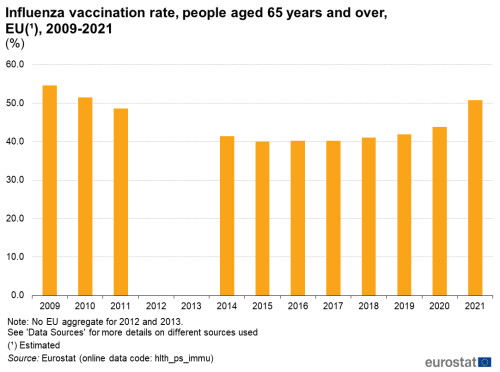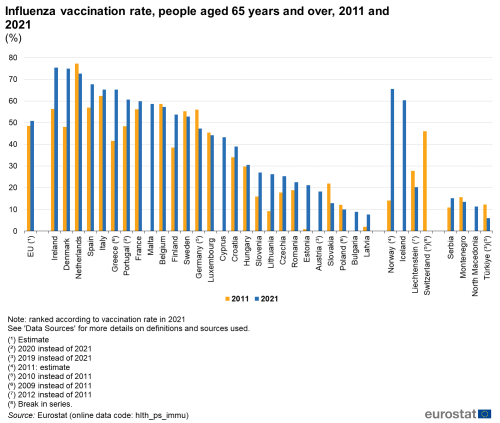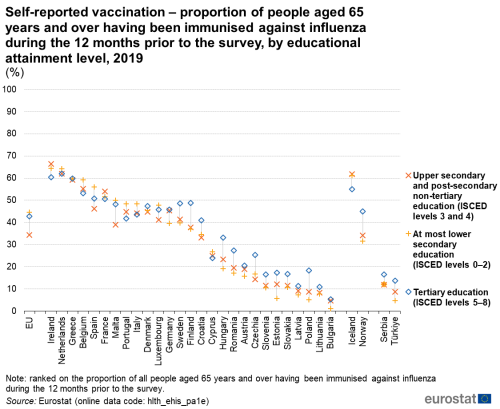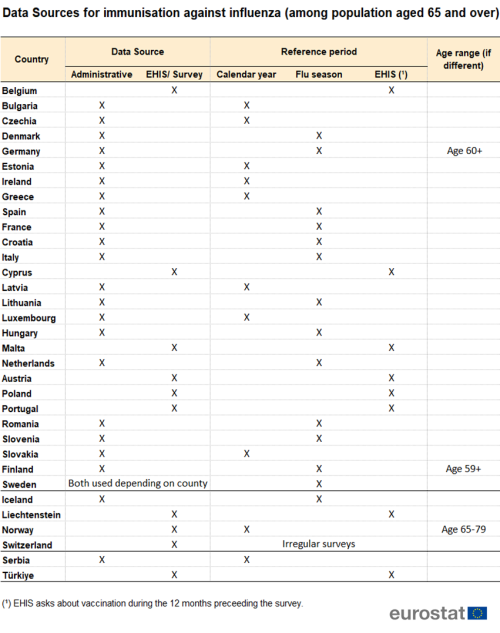Influenza statistics
Data extracted in July 2023.
Planned article update: July 2024.
Highlights
Over half of people older the 65 years were vaccinated against influenza in the EU in 2021.
Ireland had the highest vaccination rate in the EU, with 75.4 % of people over 65 being vaccinated against influenza in 2021.
There were 5 693 deaths of EU residents from influenza in 2020.
This article presents an overview of European Union (EU) statistics related to influenza.
This article presents the following data:
- Influenza vaccination rate among people 65 and over, from 2009 to 2021[1]
- Self-reported data on influenza vaccination among people 65 and over, from 2019
- Standardised death rates from influenza, by age group, from 2020
Data from 2020 and 2021 may have been impacted by the COVID-19 pandemic and its related restrictions. For this reason, particular attention should be paid when comparing with data from earlier years. In some EU Member States, healthcare resources were placed under intense pressure (particularly at the start of the pandemic) from an influx of patients with COVID-19. The pandemic also resulted in a range of knock-on effects including, among others, some services being curtailed/postponed due to the number of COVID-19 patients, staff shortages within hospitals and day care centres due to infection/quarantine procedures, and patients being hindered accessing medical services due to their own infection/quarantine as well as lockdown or travel restrictions. The COVID-19 vaccination programmes may also have increased awareness of other preventive measures, such as vaccination for influenza.
Full article
Influenza vaccination rates – based on vaccination programme data
The rate of vaccination increases in times of pandemics
In the EU, just over half (50.8 %) of people aged 65 years and older were vaccinated against influenza in 2021. Between 2009 and 2021, the rate of vaccination against influenza in the EU varied, with the lowest rate recorded in 2015 at 40.0 % and the highest recorded in 2009 at 54.6 % (no EU aggregates available for 2012 and 2013 due to lack of national data).
The influenza seasons where higher rates of vaccinations were reported occurred in the same periods as the WHO declared pandemics. The outbreak of swine flu occurred in in 2009-2010, and the influenza season 2021 came during the COVID-19 pandemic.

(%)
Source: Eurostat (hlth_ps_immu)
Vaccination rates varies between EU Member States
Among the EU Member States, there is a range of different policies with respect to making influenza vaccines available to the general public. Often these vaccines are targeted at older age-groups or other at-risk groups. Figure 2 shows the reported uptake of vaccinations against influenza among people aged 65 years and over in 2021 and 10 years earlier, in 2011. Figure 2 shows considerable differences between EU Member States in relation to the overall uptake of influenza vaccinations reported. More than three quarters (75.4 %) of persons aged 65 years and over in Ireland were vaccinated against influenza in 2021, as were 75.0 % in Denmark and more than two thirds in the Netherlands (72.6 %) and Spain (67.7 %). Less than a fifth of the elderly population were vaccinated in Austria (18.3 %, 2019 data), Slovakia (12.9 %), Poland (10 %), Bulgaria (8.9 %) and Latvia (7.7 %).
In 16 of the 23 EU Member States for which data are available for the two reference years shown in Figure 2 (see the figure for more information on the coverage), the share of the elderly vaccinated against influenza was higher in 2021 than it had been in 2011. The biggest declines were recorded in Slovakia, down 9 percentage points and Germany, down 8.8 percentage points.
By contrast, the proportion of the population aged 65 years and over that was vaccinated against influenza was more than 20 percentage points higher in 2021 than in 2011 in Estonia, and Greece (2009 data), with the highest increase recorded in Denmark (27.0 %).

(%)
Source: Eurostat (hlth_ps_immu)
Self-reported data on influenza vaccination
The latest self-reported data on influenza vaccination comes from the third wave of the European Health Interview Survey (EHIS) which was conducted in 2019; this data are presented in Figure 3. Self-reported vaccination against influenza is calculated as the percentage of the population vaccinated against flu during the past 12 months. Data is collected from all age groups but the age group 65 or over is primarily used for policy purposes and is presented here. In Hungary, Poland, Finland and Estonia, there were notably higher shares of people having been vaccinated against influenza among people having completed a tertiary level of educational attainment than among people with at most a lower secondary level of educational attainment; this was also the case in Norway. The reverse situation was observed notably in Portugal, Belgium, Spain and Italy, as well as in Iceland. When considering all three education levels together, the narrowest range in the proportion of people aged 65 years and over reporting in 2019 that they had been vaccinated against influenza during the previous 12 months, was observed in Greece.

(%)
Source: Eurostat (hlth_ehis_pa1e)
Deaths from influenza
There were 5 693 deaths of EU residents from influenza in 2020, which equates to 1.18 deaths per 100 000 inhabitants.
The highest total standardised death rate for influenza in 2020 was reported in Austria, with 3.3 deaths per 100 000 inhabitants. Belgium was the only other country to report a total standardised death rate of over 2 deaths from influenza per 100 000 inhabitants. The lowest standardised death rate for influenza was reported by Slovakia, with 0.1 deaths per 100 000 inhabitants; Poland, Hungary and Romania also reported standardised death rates of less than 0.5 deaths from influenza per 100 000 inhabitants.
The standardised death rate for influenza was considerably higher among those over 65 years old, when compared to those under 65. Austria reported the highest standardised death rate for influenza among those over 65 years old in 2020, with 14.7 deaths per 100 000 people over 65. The lowest standardised death rate for influenza in this age group was reported by Slovakia, with 0.3 deaths from influenza per 100 000 people over 65. Hungary and Romania also reported a standardised death rate of 1 or less deaths from influenza per 100 000 people over 65. In the other Member States the standardised death rate for influenza in this age group was between 1.6 (in Poland) and 9.0 (in Belgium) deaths per 100 000 people over 65.
The standardised death rate from influenza among those younger than 65 ranged from 0.6 deaths per 100 000 people under 65 in Estonia and Austria, to 0.0 deaths from influenza per 100 000 people under 65 in Malta.
Source data for tables and graphs
Data sources
This article presents data on influenza vaccinations from two main sources of data: the first relies on data from administrative sources, usually linked to the vaccination programme (see further Healthcare non-expenditure statistics – methodology). The second source is based on self-reported information from population surveys (see further European health interview survey – methodology).
For country specific notes on these data collections, please refer to the annexes at the end of the national metadata reports accessible from links at the beginning of the European metadata report.
The Healthcare non-expenditure statistics manual provides an overview of the classifications, both for mandatory variables and variables provided on voluntary basis.
Vaccination programme data
The extent of influenza vaccinations is based on the percentage of people aged 65 years and over who have been immunised against influenza during the reference period.
Vaccination rate is calculated by calendar year or influenza season. Some countries may use European health interview survey (EHIS) data to calculate the vaccination rate for influenza. Please see table below for more information on sources of influenza vaccination data.
The EU aggregate is calculated using the reference year data for each country, or if it is not available for a certain year, the value available in the most recent of the previous 5 years. The EU aggregate is a population-weighted average.
Survey data
Self-reported statistics covering the health status of the population, including vaccination rates against influenza, are provided by the European health interview survey (EHIS). This source is documented in more detail in the background article European health interview survey – methodology. The data used in this article are self-reported vaccination – proportion of people aged 65 years and over having been immunised against influenza during the 12 months prior to the survey.
Causes of death
This article also includes statistics on causes of death which are documented in more detail in this background article, which provides information on the scope of the data, its legal basis, the methodology employed, as well as related concepts and definitions.
The Eurostat causes of death data collection is based on confirmed death certificates established by medical experts assessing the underlying cause of death. There is a difference in the coding of cases of influenza deaths, where influenza was the established underlying cause of death vs where death occurred in someone who had influenza at or close to the time of death. Data on causes of death in 2020 may also be influenced by the coding for deaths from COVID-19. There may be differences in how countries determined the underlying cause of death, particularly in cases where the deceased had multiple morbidities, or coinfections with other respiratory diseases (e.g. COVID-19 or pneumonia).
Legal Basis
Heath care non-Expenditure
Regulation 1338/2008 on Community statistics on public health and health and safety at work, implemented through Regulation 2294/2022 as regards statistics on healthcare facilities, healthcare human resources and healthcare utilisation.
European health interview survey (EHIS)
Regulation 1338/2008 on Community statistics on public health and health and safety at work, implemented through Regulation 0255/2018 as regards statistics based on the European Health Interview Survey (EHIS).
Causes of Death
Regulation 1338/2008 on Community statistics on public health and health and safety at work, implemented through Regulation 0328/2011 on Community statistics on public health and health and safety at work, as regards statistics on causes of death.
Context
Vaccination is vital for of primary prevention and offers the most cost-effective, long-term strategy for reducing the burden of diseases across the EU. Immunisation through vaccination is the best defence we have against serious, preventable, and sometimes deadly, contagious diseases. Thanks to widespread vaccination, smallpox has been eradicated, Europe made polio-free, and many other diseases almost eliminated.
Influenza is an annual, seasonal virus that affects Europe in the winter. The majority of people who die from influenza are aged 65 years and over and many face other complications/illnesses, such as heart disease or chronic lung disease. During an influenza epidemic, there may be significant costs for national health services (associated with caring for those who fall sick) and for businesses in general (lost production as a result of time taken off work).
Indicators on influenza vaccination in the elderly are included in the health services chapter of the European core health indicators (ECHI).
To help countries prepare their response to a likely increase of COVID-19 and influenza in the autumn and winter 2022-2023, the Commission published a Communication on preparing for autumn and winter 2022-2023, including recommendations to combine COVID-19 and influenza vaccination campaigns where possible.
Integrating population-based surveillance systems for influenza, SARS-CoV-2 and other respiratory viruses to monitor the spread and intensity of respiratory viruses is a key recommendation published by WHO/Euro in strategy recommendations to protect the most vulnerable.
The European Centre for Disease Prevention and Control (ECDC) was set up to help strengthen Europe’s defences against infectious diseases, such as influenza, SARS, COVID-19 and HIV/AIDS. The ECDC works in partnership with national health protection bodies to strengthen and develop continent-wide disease surveillance and early warning systems.
The European Vaccination Information Portal (EVIP) was developed by the European Centre for Disease Prevention and Control (ECDC), in partnership with the European Commission and the European Medicines Agency (EMA) and includes information of influenza vaccination.
Direct access to
See also
Online publications
Causes of death
- Influenza_statistics
- Causes of death statistics by age group
- Preventable and treatable mortality statistics
Health status
Specific health conditions
- Cardiovascular diseases statistics
- Cancer statistics
- Cancer statistics — specific cancers
- Respiratory diseases statistics
- Mental health and related issues statistics
- Accidents and injuries statistics
Healthcare activities
Methodology
General health statistics articles
- Health (hlth), see:
- Health care (hlth_care)
- Preventive services (hlth_prev)
- Vaccination against influenza of population aged 65 and over (hlth_ps_immu)
- Self-reported vaccination against influenza by sex, age and educational attainment level (hlth_ehis_pa1e)
- Preventive services (hlth_prev)
- Causes of death (hlth_cdeath)
Atlas
News releases
Methodology
- Healthcare non-expenditure statistics (ESMS metadata file – hlth_res_esms)
- Causes of death (ESMS metadata file — hlth_cdeath_sims)
- Revision of the European Standard Population — Report of Eurostat's task force — 2013 edition
- European Commission – Public health, see:
- OECD – Health policies and data
- World Health Organization (WHO) – Global Health Observatory (GHO)
- World Health Organization (WHO) – Health system governance
- Joint OECD / European Commission report Health at a Glance: Europe
- WHO Global Health Observatory (GHO) — Mortality and global health estimates
Notes
- ↑ The year corresponds to the influenza season which ended in the year mentioned, for most countries (see section Data sources), alternatively the calendar year. Hence, the year 2021 corresponds to the influenza season 2020/2021 or calendar year 2021.

